
Why it is important to balance a centrifuge
A centrifuge undergoes thousands of rotations per minute, which means that the slightest weight imbalance around the rotor is magnified, and can cause the instrument to start wobbling or shaking. This impacts its performance and reliability, shortens its lifespan and, in the worst case, cause a centrifuge explosion that could injure lab personnel.
How to balance a centrifuge
If you're using a portable benchtop instrument, you need to ensure that you place your centrifuge on a level, stable surface. You then need to load it with tubes in a way that the center of gravity remains in the center of the rotor. To learn how this can be achieved for different instrument types and tube numbers, refer to the sections below.
Fixed angle rotor devices
When loading a centrifuge with a fixed angle rotor, think of your tubes in pairs, and place them across from each other. Note that the two tubes opposite one another should have the same mass, which means that they need to be filled with the same volumes of sample.
What to consider when choosing centrifuge tubes.If you have an odd number of tubes, add one 'balance tube' that you place opposite of your ‘single’ sample tube. When filling it with water to save on reagents, please note that it doesn't have to contain the same volume of liquid, but must have the same mass as the sample tube on the other side of the rotor.
Another option to balance a fixed angle rotor centrifuge with an odd number of tubes is to space them out evenly around the rotor.

How to use a centrifuge with an odd tube number
Swinging bucket rotor devices
To load a centrifuge with a swinging bucket rotor, ensure that all rotor positions are equipped with buckets, even if you leave them empty. Running the instrument without buckets could damage the rotor. In addition, you need to check that the buckets can swing out smoothly.When loading the tubes into the buckets, ensure that opposing buckets are loaded symmetrically to avoid an imbalance across the center of rotation. On top of that, each bucket has to be balanced across its pivotal axis. If one of these conditions can't be met with your sample tube number, use 'balance tubes' to help.
Centrifuge tubes are, without question, the lab consumables that have to withstand the highest forces. When selecting your tubes, you should therefore consider the factors below to avoid costly and time-consuming spills inside your centrifuge.
Relative centrifugal force
Tubes manufacturers usually specify the maximum relative centrifugal force (RCF) that their tubes can withstand. Since pricing can vary depending on this value, you should first find out what RCF is required for your workflow, then look for tubes that are designed to withstand these forces.
Relative centrifugal force (RCF)
The relative centrifugal force is the force acting on samples during centrifugation. It is indicated as a multiple of the gravitational field of Earth (g) and can be calculated as follows:
RCF = 11.2 x r x (RPM/1000)2
r: rotation radius (in cm)
RPM: rotational speed (revolutions per minute)
GO TO GLOSSARY
Chemical resistance
As your tubes are exposed to not only the RCF, but also to your samples, you should always check their chemical resistance to determine if they are suitable for your workflow. Common materials for tubes are polypropylene (PP), polyallomer (PA), polycarbonate (PC), polyethylene terephthalate (PET) and glass.
Autoclaving
Whether you can autoclave your centrifuge tubes or not also depends on their material. Tubes made from glass, PP or PA can usually be autoclaved (check with your tube manufacturer to confirm), whereas PET tubes are not autoclavable. PC tubes may be autoclaved, but repeated autoclaving shortens their lifespan, as the material loses strength.
Size
The ideal tube size depends on your sample volume. Generally speaking, tubes should be at least ¾ full – and some need to be filled completely – to avoid excessive material stress and potential tube failures. Therefore, it's best to check your manufacturer's specifications before deciding on tube size. If it turns out that the tube suitable for your sample volume is too small for your centrifuge, adapters are available for most instruments.
Screw cap vs. snap cap tubes
Another factor affecting centrifuge safety is the sealing mechanism of your tubes. Snap cap tubes are more convenient to close, especially when processing a large number of samples. Screw cap tubes, on the other hand, provide a better seal and can't accidentally pop open, even when volatile or heated samples are being handled. It is therefore up to you to find the ideal balance between efficiency and safety.
Medicalet can provide you with the best Centrifuge tubes with high Chemical resistance, various ideal tube size, Sterile product is certified free of RNase, DNase, DNA, ATP, bioburden and endotoxins.Manufactured from virgin polypropylene these microcentrifuge tubes ensure sample integrity during boiling, freezing, and centrifugation.
If you are interested in our products, please feel free to contact us and ask for samples!


